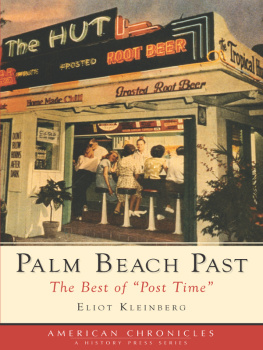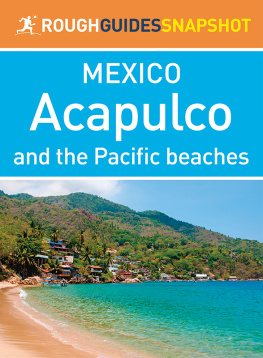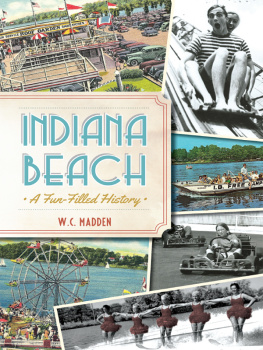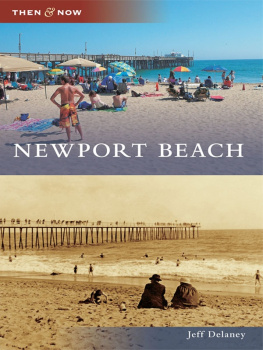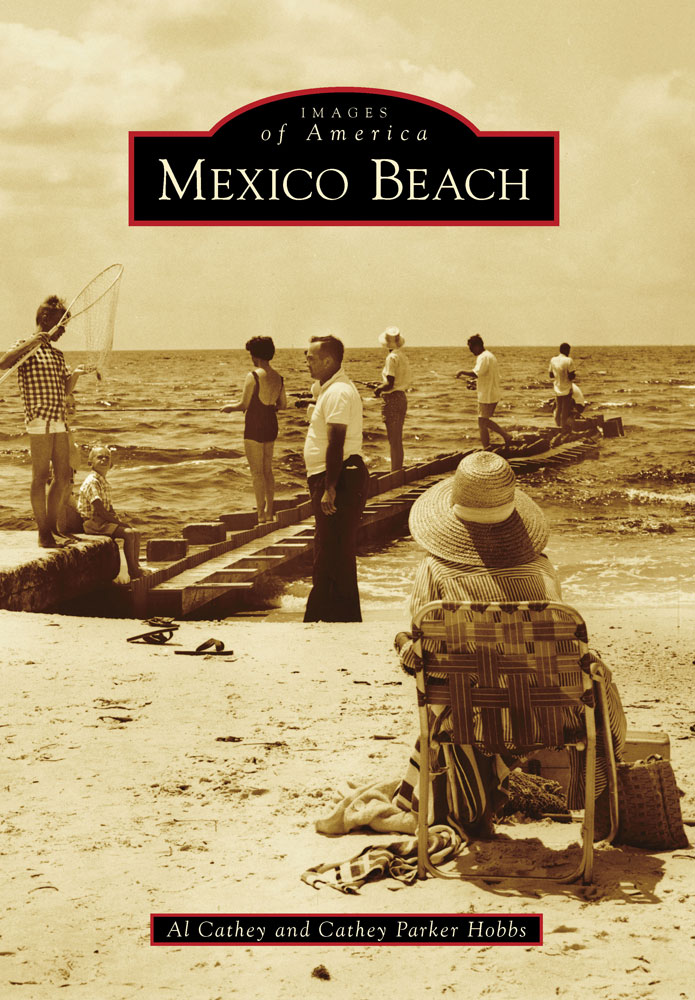
IMAGES
of America
MEXICO BEACH

Charlie and Inky Parker are seen here in their sunset years, taking a stroll on the beach and reminiscing about a great life during the summer of 2001. (Courtesy of Dana Palmer.)
ON THE COVER: A typical summer day of fishing and fun in the sun is seen in this view of the Mexico Beach jetties in 1965. (Courtesy of Florida State Archives.)
IMAGES
of America
MEXICO BEACH
Al Cathey and Cathey Parker Hobbs

Copyright 2014 by Al Cathey and Cathey Parker Hobbs
ISBN 978-1-4671-1160-7
Ebook ISBN 9781439642870
Published by Arcadia Publishing
Charleston, South Carolina
Library of Congress Control Number: 2013949111
For all general information, please contact Arcadia Publishing:
Telephone 843-853-2070
Fax 843-853-0044
E-mail
For customer service and orders:
Toll-Free 1-888-313-2665
Visit us on the Internet at www.arcadiapublishing.com
Above all, we would like to show our appreciation to our parents, Charlie and Inky Parker and Bubba and Marion Cathey, for all they did to make Mexico Beach a wonderful place to call home. It is an honor to dedicate this book to them.
CONTENTS
ACKNOWLEDGMENTS
The authors would like to thank Beverly Mount Douds for her knowledge and guidance in helping make this book a reality. Beverly has written three pictorial history books about area towns and is an avid researcher. Thank you to Judy Carrell for providing the information on Marianna Hill for the introduction. Also to be thanked are all the people who love Mexico Beach and helped by sharing their photographs and stories with us.
INTRODUCTION
Accounts of Mexico Beachs past are vague before the early 1900s. As French interests in the Americas dwindled, records indicate very little activity in the area until rumors of buried riches and sunken ships brought treasure hunters to the coast. Businessman Felix du Pont purchased the land now occupied by the city of Mexico Beach in the early 1900s. Native pine trees were harvested to produce turpentine, and the area gained a bit of exposure to public eyes. Fishermen were the first to embrace the newly discovered and newly accessible beaches. The allure of amazing spring and fall runs of migratory fish were as difficult to resist then as they are today. In 1918, Gordon Parker moved his wife and family from Brewton, Alabama, to a small town on the banks of the Apalachicola River to go into the lumber and veneer business. From then on, the Parker name would forever be linked to the area.
The 1930s saw the completion of Highway 98, which vastly increased the number of visitors to the area. In early 1941, Tyndall Field was constructed and became the training site for pilots in the Air Force. Livestock and wildlife still roamed freely along the new road and accommodations were very limited. Growth was slow, and the sleepy community remained quiet.
In April 1946, a picturesque parcel of property on the north side of Highway 98, from Route 386 west to Sea Street, was purchased by L.C. Tucker of Blountstown, through O.O. Miller, from Felix du Pont for $5,148. In that same year, Marianna native Floie Packard, the wife of John C. Packard, negotiated with Tucker to purchase a portion of the property. Due to the size of the property, Packard contacted friends and associates in hopes of finding prospective buyers. With the majority of the buyers coming from Packards hometown, Marianna Hill was born. On March 7, 1947, the Tuckers deeded the 1,350 feet of Gulf-front property to the State of Florida for its preservation and perpetual public use. The original owners shown on the deeds were Virginia Brownlee (Marianna), Julia Criglar (Marianna), Floie Packard (Marianna), Clara Farley (Marianna), Slade West (Marianna), Annie West (Marianna), Reva Greening (Springfield, Illinois), Margarite Finlayson (Marianna), Dexter McCaskill (Marianna), Bruce Singletary (Marianna), Margarite Cooper (Prattville, Alabama), H.V. Milton (Marianna), W.F. Fite (Marianna), Anna and Constance Dozier (Columbus, Georgia) Lawrence Dozier (Columbus, Georgia), Mr. and Mrs. William Johnston (Columbus, Georgia), L.L. MacKinnon (Marianna), and Margaret and Henry Hanson (Jacksonville).
In late 1946, a group of farsighted businessmen led by Gordon Parker, W.T. McGowan, and J.W. Wainwright purchased 1,850 acres along the beach for $65,000. Shortly thereafter, development began in earnest. Parkers youngest son, Charlie, soon took over development responsibilities for his fathers company, the Mexico Beach Corporation. His determination, effort, and vision shaped the area into the Mexico Beach of today. Charlie Parker and his wife, Inky, moved their lives and their two daughters to the Unforgettable Coast in 1949. Through their strong belief in God and their dedication to family values, hard work, and sacrifice, they made Mexico Beach home.
The little community suffered growing pains, with many plans for development realized and others shelved. The challenges were many, but slow growth ensued, and Mexico Beach boasted several hundred residents by 1955. Landmark accomplishments by the Mexico Beach Corporation under the guidance of Charlie Parker remain as footprints in the sand today. A beautiful, more-than-one-mile-long unobstructed view of the Gulf of Mexico is a result of all Gulf-front property from Seventh Street to Sea Street being platted and recorded for public use in 1949. In 1953, the water plant and a 100,000-gallon elevated storage tank were constructed, and in 1955, the Mexico Beach Canal became a reality. In 1957, the First United Methodist Church of Mexico Beach was organized.
By 1967, the little town was ready to incorporate, and the City of Mexico Beach was formed. Residents elected Charlie Parker as their first mayor. Since then, the beach town has kept growing steadily. Over 1,000 residents currently call Mexico Beach home. City officials have embraced Parkers vision, preserved Mexico Beachs reputation as a family-friendly vacation spot, and attracted quality mom-and-pop businesses to the Unforgettable Coast. Mexico Beach has undeniable appeal. Residents love it, and out-of-town visitors happily return year after year. Some 60 years ago, Mexico Beach was a nameless rainbow curve of white sand beaches with blue water and sloping dunes speckled with sea oats the color of weathered gold. There were no piers, no roadhouses, no motels, and no gas stations. Only Route 98, within a snapshot of the water, laid a track across the sand so fine it was compared to sugar. Those fortunate enough to visit and those blessed enough to call it home are grateful to the early families of Mexico Beach who worked tirelessly to preserve this special little place on earth.
The authors were raised by pioneer families, and their childhood days were filled with some lasting beach kid memories. Shell hunting on the beach without worries, scooping buckets of blue crabs from the Gulf, and fishing from the surf or the pier were all part of the daily routine. Exploring sand dunes and enjoying private beach cabanas were common events. Fireworks were the display of phosphorus from splashing hands and feet in the Gulf on a moonlit night. A beach social was a game of putt-putt golf or a gathering of friends and family around a bonfire enjoying hot dogs and marshmallows. A daring and exciting evening at the skating rink was punctuated by jumping Coca-Cola crates or finding oneself on the end of the whip. Beach life was good, and that has not changed.
Next page



